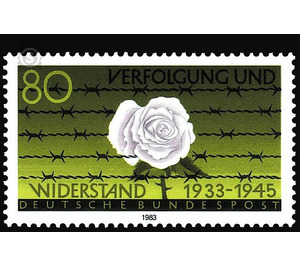Persecution and Resistance 1933-1945 - Germany / Federal Republic of Germany 1983 - 80 Pfennig
Theme: Calender
| Country | Germany / Federal Republic of Germany |
| Issue Date | 1983 |
| Face Value | 80.00 |
| Color | green |
| Perforation | K 14:14 1/4 |
| Printing Type | Six-color offset printing |
| Stamp Type | Postage stamp |
| Item Type | Stamp |
| Chronological Issue Number | 1036 |
| Chronological Chapter | GER-BRD |
| SID | 95080 |
| In 62 Wishlists | |
The stamp is intended to remind that 50 years ago, on January 30, 1933, the National Socialists took power and thus began persecution, resistance and terrible suffering. Half a century has passed since January 30, 1983, when the National Socialists came to power in Germany. This began the most disastrous time in German history. Millions of people were murdered, at the end of a wanted cruel war stood destruction and chaos. We have to live with the inhuman border that separated Germans from Germans. The anniversary will be an occasion to remember, but also to ask what lessons of this painful experience remain to us. For this reason, the German Federal Postal Service issues a commemorative stamp under the motto "Persecution and Resistance 1933-1945". Persecution and resistance - that is certainly not the whole reality of this time. Not only the state terror ensured that warnings and reminders hardly heard. At least as well do the elders remember enthusiasm and hope - especially in the early years. After the global economic crisis and millions of unemployed, it was, according to many, up again. Germany would reassert itself in the world. For the warners and admonishers, who pointed to the destruction of democracy and civil liberties, denouncing racial stupidity and exaggerated nationalism, warning of the war and accusing Nazi crimes, the concentration camps were ready. The stamp of the German Federal Post Office shows a white rose that grows out of barbed wire. »The White Rose« was the name given to a small group of Munich students around Scholl's siblings. Under the impression of Stalingrad in the winter of 1942-43 they had spoken in some pamphlets of the "return to clear, moral principles, to the rule of law, to the will of the morally good." They had to die for it. The "White Rose" has become a symbol of resistance, precisely because these young people were not motivated by a political organization, but followed their conscience and appealed to consciences. Resistance existed before and afterwards in the most varied forms: Social Democrats who voted against the Enabling Act in 1933 and continued to fight illegally, clergymen of the two churches who denounced inhumanity from the pulpits, officers who tried to eliminate Hitler on July 20, 1944 - they all risked freedom and life. But so did the countless and nameless Germans, who dared to express criticism, failed to execute ordered injustices, tried to help Jewish fellow citizens and other persecuted persons. Many people did not adapt to the totalitarian state. Their democratic resistance in those years maintained the memory and hope for a better Germany. The reconstruction of our democratic republic was able to build on them. The rose symbolizes this hope that can not be destroyed by any terror. At the same time, it urges that threats to freedom and the rule of law be counteracted at an early stage and that the lessons of history be kept alive. (Text: Federal Agency for Civic Education, Bonn)


